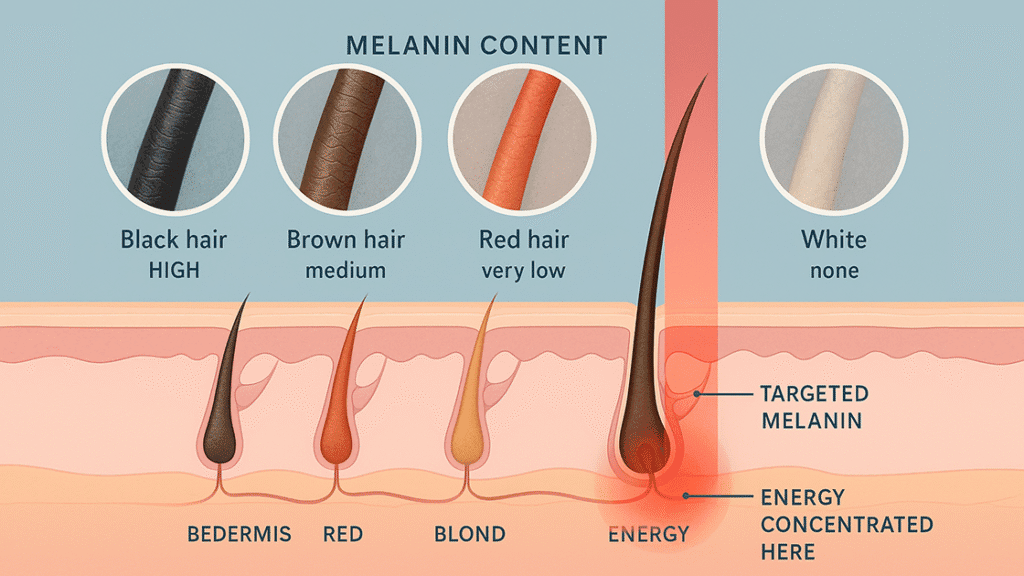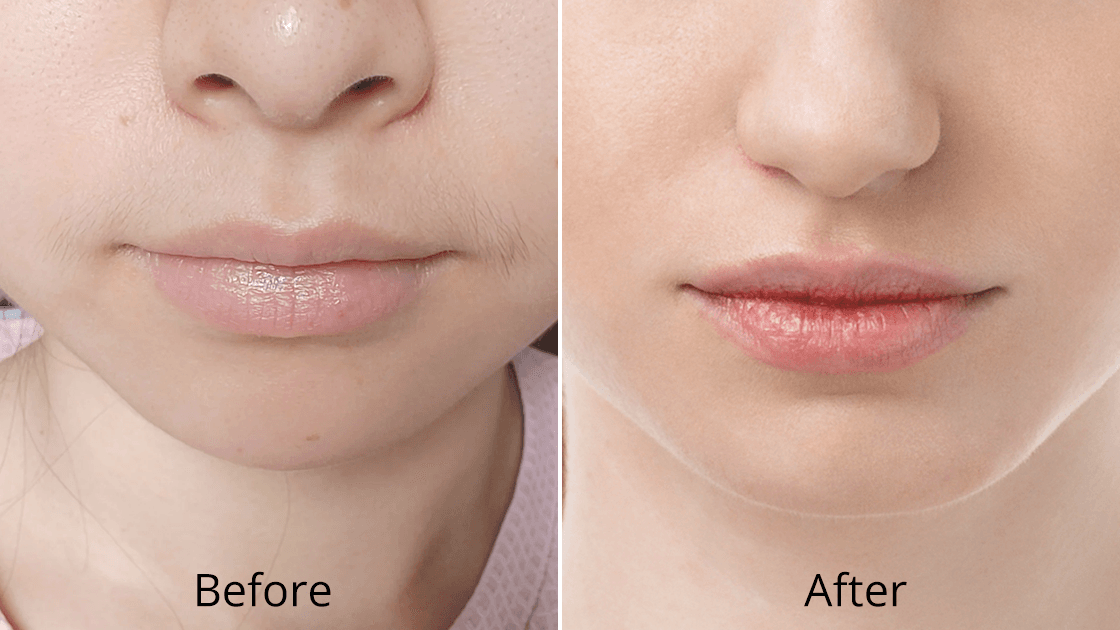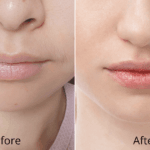1. Introduction: Cracking the Code of Laser Hair Removal
The quest for smooth, hair-free skin has led millions to discover laser hair removal, a revolutionary technology that promises long-term hair reduction. However, the effectiveness of this treatment isn’t universal—it depends significantly on the intricate relationship between laser wavelengths, hair pigmentation, and skin tone. Understanding these connections is crucial for achieving optimal results and managing realistic expectations.
1.1 What Makes Laser Hair Removal a Popular Choice
Laser hair removal has become the gold standard for permanent hair reduction, offering a sophisticated alternative to traditional methods like shaving, waxing, and plucking. Unlike temporary solutions, laser technology targets hair follicles at the cellular level, disrupting their ability to produce new hair. The treatment provides long-lasting results, with many patients experiencing significant hair reduction that can last for years. Professional-grade diode laser systems offer precision, safety, and efficacy that surpasses home-use devices. The convenience of reduced daily grooming routines, combined with the gradual improvement in skin texture and reduction of ingrown hairs, makes laser hair removal an attractive investment for both men and women seeking permanent hair reduction solutions.
1.2 Common Misconceptions About Hair and Laser Compatibility
Many people believe that レーザー脱毛 works equally well on all hair colors and skin types, leading to disappointment when treatments don’t meet expectations. A prevalent misconception is that newer laser technologies can effectively treat any hair color with equal success. Another common belief is that increasing laser power can compensate for light-colored hair, which can actually increase the risk of skin damage without improving results. Some individuals assume that multiple sessions can eventually eliminate blonde or gray hair, not understanding the fundamental biological limitations. Additionally, many people underestimate the importance of professional consultation, believing that over-the-counter devices can achieve similar results to clinical-grade equipment.
1.3 Why Hair Color Plays a Central Role
Hair color serves as the primary determinant of laser hair removal success because of the fundamental principle of selective photothermolysis. The laser energy must be absorbed by melanin pigments within the hair shaft and follicle to generate sufficient heat for thermal destruction. Different hair colors contain varying concentrations of eumelanin and pheomelanin, the two types of melanin responsible for hair pigmentation. Dark hair contains abundant eumelanin, which efficiently absorbs laser energy across multiple wavelengths. Light-colored hair, containing minimal melanin or predominantly pheomelanin, poorly absorbs laser energy, resulting in insufficient heat generation for effective follicle destruction. This biological reality explains why treatment protocols must be carefully tailored to individual hair and skin characteristics.
2. The Science Behind Laser Hair Removal
Understanding the scientific principles underlying laser hair removal reveals why certain hair colors respond dramatically differently to treatment. The interaction between laser energy and biological tissues follows precise physical and biological laws that determine treatment outcomes.
2.1 How Laser Targets Hair Follicles: A Quick Primer
Laser hair removal operates on the principle of selective photothermolysis, where specific wavelengths of light target chromophores within hair follicles while minimizing damage to surrounding tissues. The process begins when laser energy penetrates the skin and is absorbed by melanin pigments in the hair shaft, hair matrix, and follicular stem cells. This absorption converts light energy into thermal energy, rapidly heating the targeted structures to temperatures exceeding 60°C (140°F), causing coagulation and destruction of follicular components. The heat diffusion must occur faster than the thermal relaxation time of the hair follicle to achieve selective destruction. Modern diode laser systems utilize sophisticated cooling mechanisms and precise pulse durations to optimize this thermal selectivity while protecting the epidermis.
2.2 The Role of Melanin in Light Absorption
Melanin serves as the primary chromophore for laser hair removal, acting as a biological target that absorbs specific wavelengths of light. Eumelanin, the brown-black pigment abundant in dark hair, exhibits broad absorption across the visible and near-infrared spectrum, making it ideal for laser targeting. Pheomelanin, the red-yellow pigment found in blonde and red hair, has significantly lower absorption coefficients and different spectral characteristics. The concentration and distribution of melanin within hair follicles directly correlates with treatment efficacy. Hair follicles with dense melanin deposits efficiently convert laser energy into heat, while follicles with sparse melanin fail to reach therapeutic temperatures. This biological reality explains why dark, coarse hair responds dramatically better to laser treatment than fine, light-colored hair.

2.3 Wavelengths Used in Laser Hair Removal Devices
Modern diode laser systems typically utilize wavelengths in the 755-1064 nm range, with popular configurations including 808 nm, 810 nm, 940 nm, and 1060 nm wavelengths. Each wavelength offers distinct advantages for different hair and skin types. The 808-810 nm wavelength provides excellent melanin absorption while maintaining good skin penetration depth, making it versatile for various hair colors and skin tones. The 940 nm wavelength offers deeper tissue penetration and reduced epidermal absorption, making it safer for darker skin types. The 1060 nm wavelength provides the deepest penetration with minimal epidermal interaction, ideal for treating coarse hair in darker skin. Multi-wavelength systems combining these wavelengths can optimize treatment parameters for individual patient characteristics, maximizing efficacy while minimizing side effects.
2.4 Thermal Damage and Selective Photothermolysis Explained
Selective photothermolysis represents the cornerstone principle enabling safe and effective laser hair removal. This process requires precise coordination of wavelength selection, pulse duration, and fluence to achieve selective thermal damage to hair follicles while preserving surrounding tissues. The thermal relaxation time of hair follicles (approximately 10-100 milliseconds) determines the optimal pulse duration for selective heating. Pulse durations shorter than this relaxation time prevent heat diffusion to surrounding tissues, while longer pulses risk thermal damage to non-target structures. The fluence (energy per unit area) must be sufficient to raise follicular temperatures to lethal levels while remaining below the threshold for epidermal damage. Advanced diode laser systems incorporate real-time temperature monitoring and dynamic cooling to optimize these parameters continuously throughout treatment.
3. Hair Color and Laser Compatibility: What Works Best
The relationship between hair color and laser effectiveness follows predictable patterns based on melanin content and distribution. Understanding these relationships helps set realistic expectations and optimize treatment protocols.
3.1 Why Dark Hair Responds Best to Laser Hair Removal
Dark hair contains abundant eumelanin, providing optimal conditions for laser energy absorption and thermal destruction of hair follicles. The high concentration of melanin throughout the hair shaft and follicular structures ensures efficient conversion of laser energy into heat. Diode lasers still remain the gold standard in laser hair removal especially on darker skin types, with dark hair showing the most dramatic and consistent results. The dense melanin distribution creates a strong optical contrast between the target hair and surrounding tissues, enabling selective photothermolysis at lower fluences. Dark hair also tends to be coarser and have deeper follicles, providing larger target volumes for laser energy absorption. Clinical studies consistently demonstrate hair reduction rates of 70-90% for dark hair after a complete treatment series, with many patients achieving long-term hair-free results.
3.2 Challenges with Blonde, Red, Grey, and White Hair
Light-colored hair presents significant challenges for laser hair removal due to insufficient melanin content for effective energy absorption. Blonde hair contains minimal eumelanin and predominantly pheomelanin, which has poor absorption characteristics across standard laser wavelengths. Red hair, while containing some pheomelanin, lacks sufficient concentration for therapeutic heating. Grey and white hair represent the greatest challenge, as they contain virtually no melanin, making them essentially invisible to laser energy. The lack of sufficient chromophore means that even maximum safe fluences cannot generate adequate thermal energy for follicle destruction. Traditionally blonde hair has also proven challenging for laser treatment, with success rates dropping dramatically compared to dark hair. Alternative approaches or combination therapies may be necessary for these hair colors.
3.3 What Happens When Hair Has Low Melanin
When hair contains insufficient melanin, several problematic scenarios can occur during laser treatment. The primary issue is inadequate energy absorption, resulting in insufficient heating of the hair follicle to achieve thermal destruction. Low melanin content means that laser energy passes through the hair shaft without being absorbed, failing to generate the temperatures necessary for follicular coagulation. This can lead to treatment failure, with minimal hair reduction despite multiple sessions. Additionally, practitioners may be tempted to increase fluence to compensate for poor absorption, potentially causing skin damage without improving hair reduction. The lack of optical contrast between low-melanin hair and surrounding tissues makes selective photothermolysis extremely difficult to achieve. In some cases, the limited melanin present may create uneven heating patterns, resulting in partial follicle damage that allows for hair regrowth.
4. Skin Tone Matters Too: The Fitzpatrick Scale
The Fitzpatrick Scale provides a standardized framework for assessing skin phototype and predicting laser treatment outcomes. This classification system considers both genetic factors and sun exposure response to categorize skin into six distinct types.
4.1 Matching Skin Tone and Hair Color for Best Results
Optimal laser hair removal results occur when there is maximum contrast between hair color and skin tone, allowing for selective targeting of hair follicles. The best candidates for laser hair removal, for example, have fair skin with dark terminal hairs. Fitzpatrick Types I-III with dark hair represent the ideal treatment scenario, as the light skin provides minimal competing melanin while dark hair offers abundant target chromophore. The high contrast enables safe use of higher fluences, maximizing therapeutic effect while minimizing risk. Conversely, dark skin with dark hair presents challenges due to competing melanin absorption in the epidermis, requiring careful parameter selection to avoid thermal injury. Light skin with light hair offers poor contrast in the opposite direction, making effective treatment extremely difficult regardless of laser parameters.
4.2 Which Laser Types Are Safe for Darker Skin
Diode lasers with longer wavelengths (940-1060 nm) are generally safer for darker skin types (Fitzpatrick IV-VI) due to reduced epidermal melanin absorption. Thanks to its longer wavelength, it bypasses melanin in the skin to treat unwanted hair with a lower risk of side effects. The Nd:YAG laser at 1064 nm provides the deepest penetration with minimal epidermal interaction, making it the safest option for very dark skin. Advanced diode systems with integrated cooling and pulse duration optimization can safely treat Fitzpatrick Types IV-V when properly configured. Patients with dark skin (Fitzpatrick skin types IV and V) can be treated with appropriate laser selection and parameter adjustment. Multi-wavelength platforms allow practitioners to customize treatment wavelengths based on individual skin characteristics, optimizing safety and efficacy for diverse patient populations.
4.3 Risk of Burns or Hyperpigmentation in Mismatched Treatments
Inappropriate laser selection or parameter settings can result in serious complications, particularly in patients with darker skin tones. With regards to laser or light procedures, the risk of post-procedural hyperpigmentation or hypopigmentation is greater in patients with Fitzpatrick skin types IV through VI. Burns can occur when excessive energy is absorbed by epidermal melanin, causing thermal damage to the skin surface. Hyperpigmentation results from inflammatory responses that stimulate melanocyte activity, leading to darkened patches that may persist for months. Hypopigmentation can occur when melanocytes are damaged by excessive heat, resulting in permanent white spots. Darker skin contains more melanin, which can compete with hair follicles for laser absorption. This creates risks of various complications. Proper patient assessment, conservative treatment parameters, and appropriate laser selection are essential for preventing these complications.
5. Solutions for Light or Grey Hair: Is Laser Still an Option?
While traditional laser hair removal faces limitations with light-colored hair, emerging technologies and alternative approaches offer potential solutions for challenging cases.
5.1 Alternative Hair Removal Techniques
For individuals with light-colored hair unsuitable for laser treatment, several alternative hair removal methods can provide effective results. Electrolysis remains the gold standard for permanent hair removal on light hair, using electrical current to destroy individual hair follicles regardless of hair color. This FDA-approved method works by inserting a fine probe into each follicle and delivering controlled electrical energy to cauterize the hair root. While time-consuming and requiring multiple sessions, electrolysis can achieve permanent results on any hair color. IPL (Intense Pulsed Light) systems may offer limited success on some light hair types, particularly those with minimal melanin content. Professional practitioners can assess individual cases and recommend the most appropriate alternative treatment based on hair characteristics, skin type, and patient preferences.
5.2 Combining Pigmenting Agents with Laser Treatments
Innovative approaches combining topical pigmenting agents with laser treatment show promise for light-colored hair removal. Carbon-based solutions can be applied to hair follicles before laser treatment, creating artificial chromophores that absorb laser energy. These exogenous pigments temporarily darken light hair, enabling effective laser targeting. Photodynamic therapy techniques utilizing photosensitizing agents can enhance laser absorption in low-melanin hair. Some practitioners report success with combination protocols involving multiple treatment modalities. However, these approaches require careful evaluation and should only be performed by experienced practitioners familiar with advanced techniques. The safety and efficacy of pigmenting agents continue to be studied, with protocols still being refined for optimal outcomes.
5.3 What the Research Says About Success Rates
Numerous clinical studies confirm that laser hair removal is highly effective, particularly for individuals with light skin and dark hair. The contrast allows the laser to target the melanin in the hair shaft more precisely, leading to better follicle destruction. According to published research in dermatologic journals, patients with this ideal combination can expect 70–90% permanent hair reduction after a full course of treatments. However, newer technologies such as diode and Nd:YAG lasers have broadened success rates for darker skin tones and finer hair. While results can be slightly less dramatic, many individuals still achieve 60–80% reduction with minimal side effects. Success also depends on factors like the hair growth cycle, hormonal balance, and adherence to session intervals. Studies emphasize the importance of multiple sessions spaced 4–6 weeks apart to catch hairs in the anagen (growth) phase, when lasers are most effective. Overall, scientific evidence supports laser hair removal as a safe, long-lasting method for reducing unwanted hair.
| Hair Color | Average Hair Reduction Rate (%) | Notes |
| ブラック | 85–95% | Highest efficacy; rich in melanin, ideal for laser absorption |
| Dark Brown | 80–90% | Responds well; good melanin content |
| Light Brown | 70–85% | Effective, though slightly less responsive than darker tones |
| Blonde | 40–60% | Lower melanin; may require higher power or additional sessions |
| レッド | 30-50% | Low melanin; specific wavelengths like 755 nm may improve results |
| Gray / White | 0–20% | Minimal to no melanin; traditional lasers are largely ineffective |
6. Real-World Expectations and Patient Education
Setting realistic expectations through comprehensive patient education is crucial for successful laser hair removal outcomes. Understanding individual factors that influence treatment success helps patients make informed decisions about their hair removal journey.
6.1 Importance of a Professional Hair and Skin Assessment
Professional assessment forms the foundation of successful laser hair removal treatment, requiring thorough evaluation of multiple factors that influence treatment outcomes. Practitioners must assess hair color, texture, density, and growth patterns across different body areas, as these characteristics can vary significantly even within the same individual. Skin tone evaluation using the Fitzpatrick Scale helps determine appropriate laser parameters and potential risks. Medical history review identifies factors that may affect treatment, including medications, hormonal conditions, and previous hair removal experiences. Hormonal influences, particularly in women, can significantly impact hair growth patterns and treatment response. A comprehensive assessment also considers patient lifestyle factors, treatment goals, and budget constraints to develop realistic treatment plans tailored to individual needs.
6.2 Why Multiple Sessions Are Required
The biological nature of hair growth cycles necessitates multiple treatment sessions to achieve optimal results. Hair follicles cycle through three distinct phases: anagen (active growth), catagen (transition), and telogen (resting). Laser hair removal is most effective during the anagen phase when hair follicles contain maximum melanin and are metabolically active. At any given time, only 10-25% of hair follicles are in the anagen phase, requiring multiple sessions to target all follicles as they enter this growth phase. Treatment intervals typically range from 4-8 weeks, depending on body area and individual hair growth patterns. Most patients require 6-8 sessions for optimal results, with some individuals needing additional treatments based on hair characteristics and hormonal factors. Maintenance sessions may be necessary to address any regrowth or newly activated follicles.

6.3 Pre- and Post-Care Tips for All Hair Colors
Pre-Treatment Tips
Avoid sun exposure for 2–4 weeks before treatment to reduce the risk of burns or pigmentation changes.
Shave the treatment area 24–48 hours prior to your session for optimal laser penetration.
Do not wax, pluck, or thread the area for 4–6 weeks beforehand — the hair root must be present for the laser to work.
Avoid topical products like retinoids, exfoliants, or self-tanners a few days before treatment.
Clean skin only on treatment day — no lotions, deodorant, or makeup on the area.
Post-Treatment Tips
Apply soothing products such as aloe vera or prescribed creams to calm the skin.
Avoid sun exposure and tanning beds for at least 1–2 weeks post-treatment.
Skip saunas, hot showers, and intense workouts for 24–48 hours to reduce irritation.
Moisturize regularly to maintain skin hydration and support recovery.
Do not pick or scratch treated areas — let any redness or bumps subside naturally.
7. Conclusion: Understanding the Color Equation for Success
The relationship between hair color, skin tone, and laser parameters creates a complex equation that determines treatment success. Understanding these interactions empowers both practitioners and patients to make informed decisions about laser hair removal.
7.1 Why Knowing Your Hair Color Changes the Game
Understanding your hair color’s compatibility with laser treatment fundamentally changes approach and expectations for hair removal. Dark hair offers the best prognosis for dramatic, long-lasting results with minimal sessions required. Light hair requires alternative approaches or combination therapies to achieve satisfactory outcomes. This knowledge prevents disappointment and unnecessary treatment attempts that may prove ineffective. Patients with realistic expectations based on hair color compatibility are more likely to be satisfied with their results. Early assessment of hair color compatibility also allows for budget planning and treatment scheduling that aligns with expected outcomes. Professional consultation considering hair color as a primary factor ensures appropriate treatment selection and optimal resource allocation.
7.2 Key Takeaways for Choosing the Right Laser Treatment
Selecting appropriate レーザー治療 requires careful consideration of multiple factors beyond hair color alone. Diode lasers with multiple wavelengths offer versatility for treating diverse hair and skin combinations. Longer wavelengths (940-1060 nm) provide safer options for darker skin types while maintaining efficacy. Professional-grade systems with advanced cooling and parameter control optimize safety and results. Treatment protocols should be customized based on individual hair and skin characteristics rather than using one-size-fits-all approaches. Realistic timeline expectations based on hair color compatibility prevent disappointment and ensure treatment completion. Investment in professional consultation and quality equipment ultimately provides better outcomes than attempting treatment with inappropriate devices or parameters.
7.3 Consultation Is Key—Color Isn’t the Whole Story
While hair color plays a crucial role in laser hair removal success, comprehensive consultation reveals additional factors that influence treatment outcomes. Skin tone, hair texture, hormonal status, medical history, and treatment area all contribute to overall success. Professional practitioners can identify subtle characteristics that may not be apparent to patients but significantly impact treatment planning. Consultation allows for discussion of alternative treatments when laser hair removal may not be optimal. Personalized treatment plans considering all relevant factors provide better results than focusing solely on hair color. Ongoing assessment and protocol adjustment throughout the treatment series ensure optimal outcomes. The complexity of laser-tissue interactions requires professional expertise to navigate successfully, making consultation an essential component of successful hair removal treatment.
8.よくあるご質問
Laser hair removal struggles with blonde hair due to low melanin. Some darker-rooted blonde hairs may respond, especially with multi-wavelength diode lasers. However, results are often partial. Electrolysis remains the most reliable option for permanent removal. New methods combining pigmenting agents with lasers show early promise but aren’t widely used yet.
White hair lacks melanin, so lasers and IPL don’t work. Electrolysis is the most effective method, targeting each follicle with electric current. Some experimental methods—like photodynamic therapy or carbon-based techniques—are being explored, but they’re not commonly available. A consultation can help identify the best personal solution.
No. Regular hair dye colors the surface but doesn’t affect melanin in the follicle, which lasers target. Therefore, dyeing doesn’t enhance effectiveness. Only special pigmenting agents designed for laser use might help, but these differ from standard dyes and should be used under expert guidance.
The contrast between hair and skin is key. Light skin with dark hair gives the best results. Dark skin with dark hair can still work but needs careful settings to avoid skin damage. Light hair on any skin tone is harder to treat. Professional assessment ensures safer, more tailored treatment.
It depends. Light brown or dark blonde hair may see some success, though not full removal. Very light blonde, red, or gray hair usually doesn’t respond well. A consultation can set expectations and explore alternatives like electrolysis, which may be more cost-effective in the long term.








